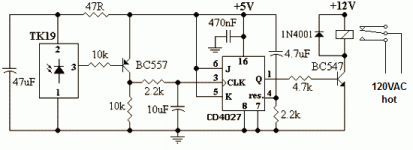I plan on building a system with mostly DIY parts... Well at least all of my amps will be boards and I have a processor/preamp that I will use to control the system... I am willing to build my own power supply or maybe just get a regulated one for what I need... This will be an all active system so the amps will be enclosed... How to I go about turning everything off with a remote control other than turning a switch off on the wall that turns the power on?
Something like this:
Linx Technologies rf modules RF Modules | Mouser
http://www.mouser.com/ds/2/238/OTX-xxx-HH-LR8-HS_Data_Guide-14250.pdf
I'm not sure where the other half is...
Linx Technologies rf modules RF Modules | Mouser
http://www.mouser.com/ds/2/238/OTX-xxx-HH-LR8-HS_Data_Guide-14250.pdf
I'm not sure where the other half is...
Google PIC IR remote. This will show you lots of options for PIC-based infrared controllers, including learning receivers which you can teach to understand your existing TV or other control.
You need a little hole or plastic plate (smoked) to allow the IR to get to the receiver (chip).
You need a little hole or plastic plate (smoked) to allow the IR to get to the receiver (chip).
None of those links actually supply me with info I am requesting... I guess what I'm looking for is an interrupt betweenmy house 120vac outlet and my power supply so I can kill the peer going to the amps when they are not in use... Basically killing power (turning off the switch I'm my house) without having to hook my power supply up to a switch.... Basically turning on a switch in my house with remote control with high power...
If you're in the US.
Amazon.com: 1 pack of 3 Remote Control BH9936-3 Power Switches: Computers & Accessories
Or google 'Remote Control Power Switch'
Amazon.com: 1 pack of 3 Remote Control BH9936-3 Power Switches: Computers & Accessories
Or google 'Remote Control Power Switch'
Connect the remote receiver output to a relay with contacts rated for your house voltage and current draw. The contacts will be in series with the AC hot lead. Or a DPDT relay switching both hot and neutral. The relay switches the power on and off.None of those links actually supply me with info I am requesting...
Attachments
Connect the remote receiver output to a relay with contacts rated for your house voltage and current draw. The contacts will be in series with the AC hot lead. Or a DPDT relay switching both hot and neutral. The relay switches the power on and off.
Hi,
Are the +5V and +12V are two separate power input ? How does the IR receiver decode which key press is valid to triggering the relay?
Thanks
The schematic shown is the receiving end of a simple on-off remote control system. The 5V can be had by regulating the 12V down with a 7805. Both links I provided are for an on-off function only. You should probably go with a PIC or other MCU if you want to modulate codes onto the transmission.
sunrom.com
Available here. However how to use them in your system will need some thinking.
Gajanan Phadte
Available here. However how to use them in your system will need some thinking.
Gajanan Phadte
If you're in the US.
Amazon.com: 1 pack of 3 Remote Control BH9936-3 Power Switches: Computers & Accessories
Or google 'Remote Control Power Switch'
I have something similar to this that I use for a light bar I have installed behind my tv... My ownly problem with this is the current output limitations to this device has.. 10 amps won't cover the 1000+ watt setup I plan on building... Something like this that is designed to handle more current would be great as opposed to going the DIY route.
I have something similar to this that I use for a light bar I have installed behind my tv... My ownly problem with this is the current output limitations to this device has.. 10 amps won't cover the 1000+ watt setup I plan on building... Something like this that is designed to handle more current would be great as opposed to going the DIY route.
So have it run a relay.
- Status
- Not open for further replies.
- Home
- Amplifiers
- Power Supplies
- Adding a infrared or rf remote to a DIY system
